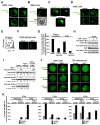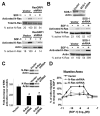G alpha i2 and ZAP-70 mediate RasGRP1 membrane localization and activation of SDF-1-induced T cell functions
- PMID: 21856938
- PMCID: PMC3169754
- DOI: 10.4049/jimmunol.1100206
G alpha i2 and ZAP-70 mediate RasGRP1 membrane localization and activation of SDF-1-induced T cell functions
Abstract
RasGRP1, a Ras guanine-nucleotide exchange factor, critically mediates T cell development and function and controls immunodeficiency and autoimmunity. In this study, we describe a unique mechanism of mobilization and activation of RasGRP1 in response to SDF-1, a chemokine that signals via the G protein-coupled receptor CXCR4. Depletion of RasGRP1 impaired SDF-1-stimulated human T cell migration, expression of the activation marker CD69, and activation of the ERK MAPK pathway, indicating that RasGRP1 mediates SDF-1 functions. SDF-1 treatment caused RasGRP1 to localize to the plasma membrane to activate K-Ras and to the Golgi to activate N-Ras. These events were required for cellular migration and for ERK activation that mediates downstream transcriptional events in response to SDF-1. SDF-1-dependent localization of RasGRP1 did not require its diacylglycerol-binding domain, even though diacyglycerol was previously shown to mediate localization of RasGRP1 in response to Ag stimulation. This domain was, however, required for activity of RasGRP1 after its localization. Intriguingly, SDF-1 treatment of T cells induced the formation of a novel molecular signaling complex containing RasGRP1, Gαi2, and ZAP-70. Moreover, SDF-1-mediated signaling by both Gi proteins and ZAP-70 was required for RasGRP1 mobilization. In addition, RasGRP1 mobilization and activation in response to SDF-1 was dependent on TCR expression, suggesting that CXCR4 heterodimerizes with the TCR to couple to ZAP-70 and mobilize RasGRP1. These results increase understanding of the molecular mechanisms that mediate SDF-1 effects on T cells and reveal a novel mechanism of RasGRP1 regulation. Other G protein-coupled receptors may similarly contribute to regulation of RasGRP1.
Figures






Similar articles
-
Distinct role of ZAP-70 and Src homology 2 domain-containing leukocyte protein of 76 kDa in the prolonged activation of extracellular signal-regulated protein kinase by the stromal cell-derived factor-1 alpha/CXCL12 chemokine.J Immunol. 2003 Jul 1;171(1):360-7. doi: 10.4049/jimmunol.171.1.360. J Immunol. 2003. PMID: 12817019
-
CXCR4 physically associates with the T cell receptor to signal in T cells.Immunity. 2006 Aug;25(2):213-24. doi: 10.1016/j.immuni.2006.06.015. Immunity. 2006. PMID: 16919488
-
A diacylglycerol-protein kinase C-RasGRP1 pathway directs Ras activation upon antigen receptor stimulation of T cells.Mol Cell Biol. 2005 Jun;25(11):4426-41. doi: 10.1128/MCB.25.11.4426-4441.2005. Mol Cell Biol. 2005. PMID: 15899849 Free PMC article.
-
A Focused Review of Ras Guanine Nucleotide-Releasing Protein 1 in Immune Cells and Cancer.Int J Mol Sci. 2023 Jan 13;24(2):1652. doi: 10.3390/ijms24021652. Int J Mol Sci. 2023. PMID: 36675167 Free PMC article. Review.
-
The role and regulation of mTOR in T-lymphocyte function.Arch Immunol Ther Exp (Warsz). 2012 Jun;60(3):173-81. doi: 10.1007/s00005-012-0171-4. Epub 2012 Apr 8. Arch Immunol Ther Exp (Warsz). 2012. PMID: 22484804 Free PMC article. Review.
Cited by
-
The Golgi in cell migration: regulation by signal transduction and its implications for cancer cell metastasis.ScientificWorldJournal. 2012;2012:498278. doi: 10.1100/2012/498278. Epub 2012 May 1. ScientificWorldJournal. 2012. PMID: 22623902 Free PMC article. Review.
-
Neurokinin-1 Receptor Signaling Is Required for Efficient Ca2+ Flux in T-Cell-Receptor-Activated T Cells.Cell Rep. 2020 Mar 10;30(10):3448-3465.e8. doi: 10.1016/j.celrep.2020.02.054. Cell Rep. 2020. PMID: 32160549 Free PMC article.
-
IQGAP1 promotes CXCR4 chemokine receptor function and trafficking via EEA-1+ endosomes.J Cell Biol. 2015 Jul 20;210(2):257-72. doi: 10.1083/jcb.201411045. J Cell Biol. 2015. PMID: 26195666 Free PMC article.
-
RASGRP1 deficiency causes immunodeficiency with impaired cytoskeletal dynamics.Nat Immunol. 2016 Dec;17(12):1352-1360. doi: 10.1038/ni.3575. Epub 2016 Oct 24. Nat Immunol. 2016. PMID: 27776107 Free PMC article.
-
CXCR4 chemokine receptor signaling induces apoptosis in acute myeloid leukemia cells via regulation of the Bcl-2 family members Bcl-XL, Noxa, and Bak.J Biol Chem. 2013 Aug 9;288(32):22899-914. doi: 10.1074/jbc.M113.449926. Epub 2013 Jun 24. J Biol Chem. 2013. PMID: 23798675 Free PMC article. Clinical Trial.
References
-
- Suzuki Y, Rahman M, Mitsuya H. Diverse transcriptional response of CD4(+) T cells to stromal cell-derived factor (SDF)-1: cell survival promotion and priming effects of SDF-1 on CD4(+) T cells. J Immunol. 2001;167:3064–3073. - PubMed
-
- Kumar A, Humphreys TD, Kremer KN, Bramati PS, Bradfield L, Edgar CE, Hedin KE. CXCR4 physically associates with the T cell receptor to signal in T cells. Immunity. 2006;25:213–224. - PubMed
Publication types
MeSH terms
Substances
Grants and funding
LinkOut - more resources
Full Text Sources
Other Literature Sources
Research Materials
Miscellaneous

